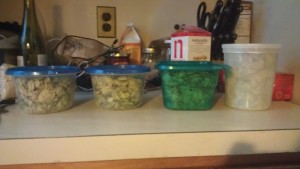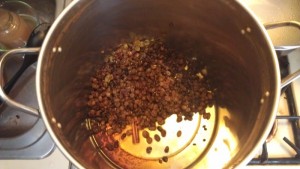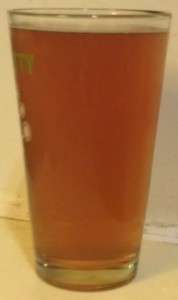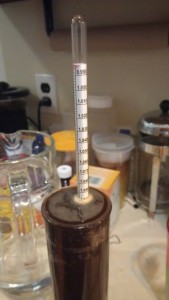Two months ago, when I last posted about homebrew on here, I had just bottled the KK and racked an English barleywine. The KK has turned out quite nicely, with definite caramel notes from the malt and sugars plus an almost fruity note from the Bramling Cross hops, which serve as a nice foil to the earthy Goldings.
The barleywine spent a month in secondary. One gallon was left alone while the other gallon had oak cubes soaked in Lagavulin whisky in the jar. Both turned out quite delicious, with the oak-aged version (dubbed The Howler*) showing some pleasant woody notes and the unoaked version (dubbed The Limper*) tasted like a drier version of JW Lee’s Harvest Ale. Both beers are definitely drier than intended, and have already started to take on some port-like character which I usually associate with aged barleywines. Next time around, I want to get the starting gravity higher in order to hit a similar ABV (11.8%) yet have a sweeter, fuller bodied finish.
The Calypso Pale Ale, our experiment with a relatively new hop variety called Calypso, turned out very well. It’s roughly 5% ABV and very clean drinking, with notable floral and lightly fruity flavors from the hop. I took a bottle to a recent homebrewer meetup where it elicited the comments “This would be a great summer beer” and “This is definitely a recipe to make again.” It’s a bit murkier that I hoped, though I’m not sure if that’s due to my usual inability to effectively clear up the wort in all-grain batches or the yeast (Wyeast 1056 American Ale) taking a lot longer to flocculate out.Ever since I started repitching yeast about a year ago, I’ve started planning our recipes in sets with common yeast and increasing strength. The pale ale was the first of four beers brewed with the 1056 yeast. Next was batch #31 and dubbed the Wilbert Montgomery ale, named for the guy who wore 31 on the Eagles back when I was a kid. I suppose you could call it a brown ale, a dark old ale, or simply a dark ale. I usually go with American strong dark ale, as it’s fairly strong (7%), it’s quite dark, and it’s an ale brewed with American yeast. I suppose I like descriptive style names. Originally modeled after beers like Pretty Things’ St. Boltoph’s Town and Smuttynose’s Really Old Brown Dog, I ended up taking the recipe I drew up for the dark mild I made in October and doubled everything.
That seemed like such a fun idea that I decided to triple the mild recipe for the fourth beer brewed with the 1056, which is called Stormbringer*. It is a 2 gallon batch, which meant I could make it very strong without having to resort to buying lots (or any) extract. I shifted the percentages slightly in the end, as I didn’t want the chocolate malt to overwhelm the entire affair. It was a proud brewday, as I broke the triple-digit gravity points boundary for the first time with a potent 1.100 original gravity. I racked it a couple weeks ago to age for a month before bottling and it’s down to 1.020, which means it’s similar in strength to the barleywines yet has a much bigger mouthfeel. Both the Wilbert Montgomery and the Stormbringer are rich, somewhat chocolatey, and a little nutty. The Stormbringer is definitely sweeter, which makes sense given its relatively high finishing gravity.
The hop additions for the Double Joe Montana. From left to right: 60 minute, 20 minute, 10 minute, and 0 minute additions.

The mess left in the bottom of the kettle -- hops, raisins, Zante currants, and a cinnamon stick. Tasty.
Next weekend we’ll be bottling what we can of the sour with oak and dates, then there will be no brewing happening until mid-April as we’re off on vacation for the first two weeks of next month.
*At some point, we decided to begin naming very strong beers after members of The Ten Who Were Taken, a group of enormously powerful wizards from The Black Company series of books by Glen Cook. The Limper, The Howler, and Stormbringer are the first three names we’ve used.


